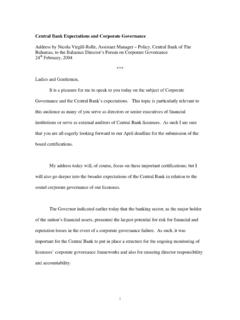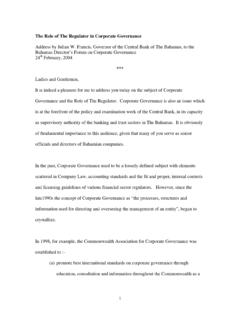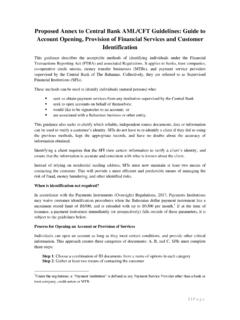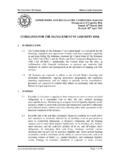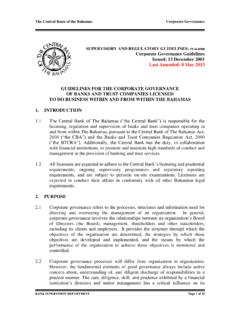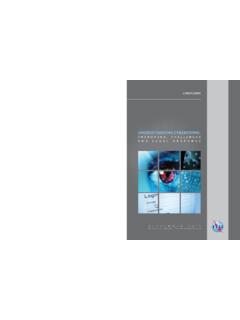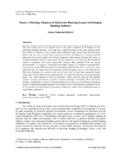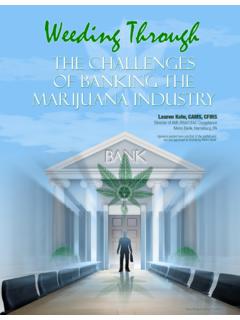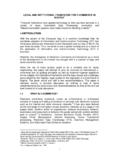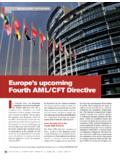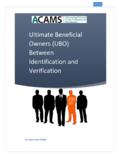Transcription of CONSULTATION DOCUMENT AML/CFT SUPERVISORY …
1 CONSULTATION DOCUMENT . AML/CFT SUPERVISORY STRATEGY. Central Bank of The Bahamas Bank Supervision Department December 2017. 1. Executive summary The Central Bank of the Bahamas ( the Bank ) regulates and supervises Bahamian banks, trust companies, co-operative credit unions, and money transmission companies (collectively, supervised financial institutions or SFIs ). Traditionally, the Bank has focused its efforts upon ensuring SFI financial soundness. The Bank also periodically examines each SFI's compliance with the relevant obligations regarding anti-money laundering ( AML ), countering the financing of terrorism ( CFT ), and related requirements. These obligations are determined by Bahamian legislation, regulation, and SUPERVISORY guidance, which in turn are informed by international standard setting bodies such as the Financial Action Task Force (FATF), the Basel Committee on Banking Supervision, and others. The Bank has concluded that Bahamas SFIs, and the Bahamian financial system, will be better served if the Bank shifts from periodic examination of AML/CFT risks, to continuous supervision of these risks.
2 In addition to continuing the current examination regime, the Bank will substantially lift its offsite surveillance and assessment of AML/CFT risks. Broadly speaking, the Bank will deploy the same tools and resources on AML/CFT risks that it currently deploys on financial failure risks. This paper outlines the Bank's proposed approach to this task. These reforms meet several of the Bank's objectives, as follows: 1) The Bahamian financial system, economy, and society will be better protected from financial crime, and the many harms that flow from this criminality. 2) The Bahamas' financial system will benefit from an appreciable improvement in its reputation for managing AML/CFT risks. At the jurisdictional level, this issue is broader than the banking system, or for that matter the financial system. Strong bank and trust company management of AML/CFT risks is necessary, though not sufficient, for The Bahamas as a jurisdiction to be perceived as lower risk. 3) Rather than imposing new and expensive requirements on the industry, we intend to achieve the above benefits by better organizing, and in some cases repurposing, the extensive national effort already flowing into AML/CFT risk management.
3 The Bank intends to commence continuous supervision of SFI AML/CFT risks from 1 January 2018. The Bank is inviting comments from interested parties on any aspect of this paper. The bank intends to consult formally on a number of issues, with conclusions reached during 2018, on some specific questions raised in this paper. We anticipate that by December 2018, the Bank will release a version of its AML/CFT supervision regime, informed by the lessons learned and consultations undertaken during the year. The Bank's supervision teams have been re-organized, within the same resource base, and the Bank has created a separate Analytics Unit to focus on AML/CFT Analytics, which should enhance AML. SUPERVISORY framework and facilitate better interaction between prudential and AML/CFT . supervision. The new Analytics Unit will implement an ongoing and annual reporting regime, track and collect the relevant data, perform risk-focused assessments, support more targeted examinations of SFI.
4 Compliance programs, and generally support inter-agency co-operation in the AML space, including participation in any national assessments of risk. 2. Coordinated but separate supervision of financial soundness and AML/CFT risks It is possible for an SFI to present a sound financial position, with deficient AML/CFT risk management, or vice versa. Accordingly, the Bank will supervise SFIs for both financial and AML/CFT risks, and will intervene if either or both risks require intervention. The Bank will separately rate and rank SFIs, and respond accordingly, for their financial and their AML/CFT risks. SFIs will not be able to argue that SUPERVISORY intervention on one family of risks should be reduced because the SFI is strong in the other area. The SUPERVISORY approach to AML/CFT risks As with financial risk, the Bank proposes to supervise AML/CFT risks by deploying an annual cycle of supervision, supplemented by examinations when appropriate, and by SUPERVISORY intervention if needed.
5 The AML/CFT supervision approach will likely rely relatively more on documents, and less on reported numbers, than the financial supervision approach. The core elements in the annual SUPERVISORY cycle include: 1) Collecting information 2) Risk analysis, rating, and ranking 3) Updating and executing the SUPERVISORY action plan. Collecting information The financial supervision cycle relies upon a great many quantitative inputs. The Bank expects that the AML/CFT cycle will rely more heavily upon documentary input. For example, Examiners would seek to ensure that risk mitigation measures are documented in the SFIs' enhanced due diligence procedures for high risk clients. We also expect that the periodicity of the AML/CFT cycle will feature relatively more annual material, and less weekly, monthly, and quarterly material, relative to financial supervision. From each SFI, the Bank intends to collect the following material: The governance, risk management, and compliance reports relevant to AML/CFT .
6 At minimum, each SFI will need an AML/CFT risk management strategy and plan, subject to no less than annual review by the board. Any relevant internal and external audit reports, with associated managerial responses, and the follow-up reports that audit items have been closed or are overdue. These reports should be issued to the Bank as they are received by each SFI. Context data to support institutional and national risk assessments, such as: (i) amount of business that is domestic or cross-border; and (ii) relative importance of different types of financial products ( transaction volumes). The AML/CFT -related reporting generated for each SFI's Board of Directors (and the applicable Board Committee). The Bank intends to meet at least annually with each SFI's MLRO, without other management present. The Bank already holds separate meetings with internal auditors, and the scope of these meetings will expand to include more attention to AML/CFT matters. 3. Information related to new staff training, and the date(s) and outcomes of the requisite annual AML/CFT training for extant staff.
7 Some of the qualitative and quantitative data collected in the Correspondent Banking Survey, issued in 2015 and 2016, will also be integrated into these ongoing efforts. An annual and substantial self-assessment, with or without auditor review (see Approach 2. below). Regarding suspicious activity, a reporting structure is proposed which would capture the number of STRs associated with: - CDD obligations - record keeping obligations - beneficial ownership information obligations - PEPs (domestic and foreign). - correspondent banking - wire transfers rules - targeted financial sanctions related to TF. - higher-risk countries (as identified by the FATF). - the number of STRs sent about suspected misuse of legal persons or legal arrangements - the number of business relationships or transactions which have been rejected or terminated due to concerns about CDD. The Bank intends to track and collect additional material from other sources: The Bank is developing a mechanism to monitor some of the suspicious transaction data aggregated by the Financial Intelligence Unit (FIU).
8 The data will be received on a recurring basis. This will help the Bank to spot trends, conduct peer reviews, develop typologies and, possibly, highlight systemic challenges faced by our SFIs. Over time, it is anticipated that this process will improve the quality of STRs produced. The Banking and Exchange Control Departments can also produce information useful to AML/CFT supervision. Open issue: should the Bank commission thematic industry reviews? What is the role of auditors? The Bank is considering how it might better coordinate with SFIs and the audit profession on AML/CFT matters. Some jurisdictions require extensive and formal auditor engagement with supervisors. The Bank is considering two potential approaches. Depending upon what is learned from CONSULTATION and supervision during 2018, the Bank may deploy either, neither, or both of these approaches. Approach 1: Annual thematic reviews Under this approach, every year the Bank would nominate a theme (such as onboarding, transaction monitoring, or SFT reporting) and prepare a standard template for each auditor to apply to relevant SFIs.
9 The Bank would then receive and analyse these thematic reports, and would share the results publicly on an aggregate basis. Issues with individual SFIs would be raised as a SUPERVISORY matter with the relevant SFI. 4. It is an open question whether the Bank would require thematic reports from internal or external auditors. CONSULTATION and a subsequent decision on this issue will occur during 2018. Approach 2: Comprehensive self-assessments The Bank could develop a standard format from which each SFI would undertake a self-assessment of its AML/CFT risk management and compliance. This self-assessment would be reported to each SFI's board, and (with any relevant board commentary or resolutions) reported to the Bank. At a minimum, such a self-assessment would require internal audit sign-off. The Bank is considering whether external audit sign-off would also be necessary. Furthermore, it may be the case that external audit sign-off is necessary less often than annually, perhaps on the initial self-assessment, and every three years thereafter.
10 Risk analysis, rating, and ranking Having collected information across all SFIs, the Bank's supervisors will at least annually conduct a formal assessment of each SFI's AML/CFT inherent risks and controls. The Bank's intent, subject to experience as it commences continuous AML/CFT supervision, is that the annual review dates should be coordinated between the Bank and each SFI, such that any relevant SFI annual internal reviews would flow into the Bank's annual review. In line with the Bank's current scoring system for risk assessments, the annual review will utilize the same numeric rating, ranging from 1 [low] through 5 [high], on the following AML/CFT risk factors: Inherent Risks: Nature of business: the inherent risks relative to nature, scale, diversity and complexity of the business; that is, the type and frequency of transactions volume and size, conflicts of interest or potential market abuse. Products & Services: the vulnerabilities of different product types and services, such as using multiple distribution channels, and attempts to disguise the source of property so that it cannot be linked to a criminal activity.
